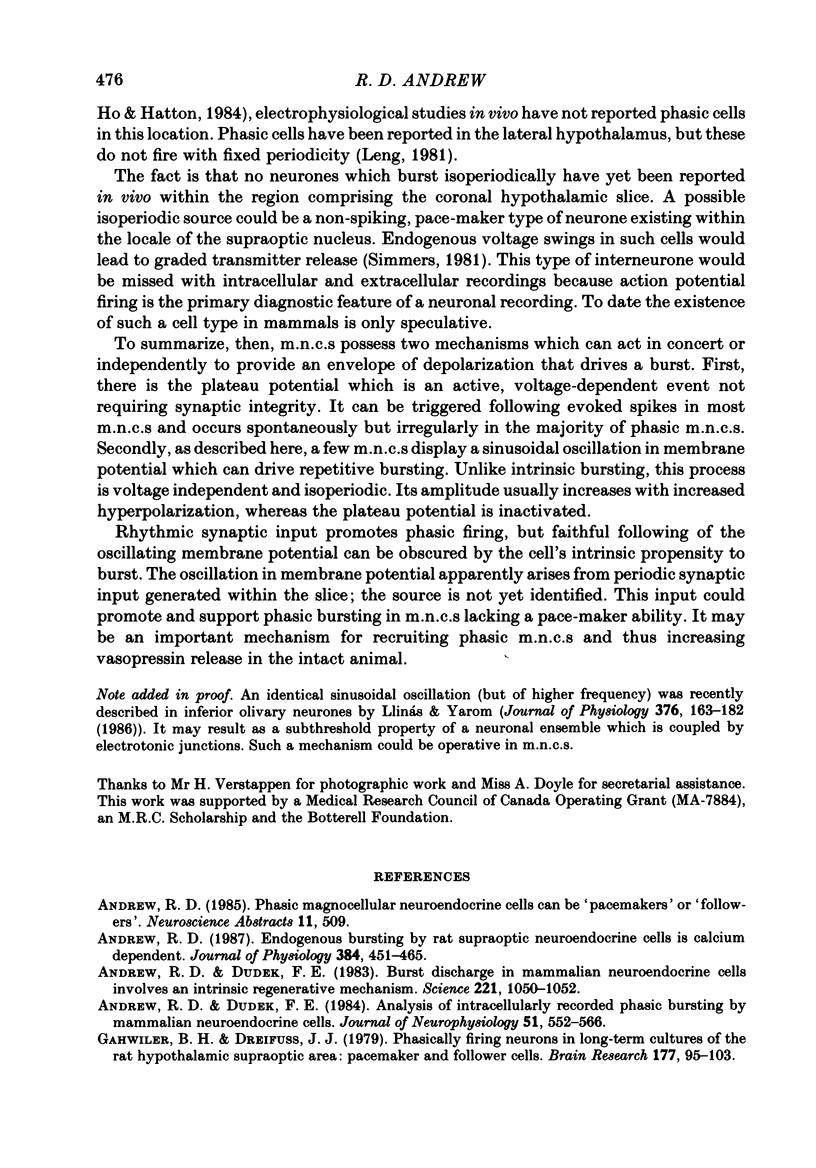Abstract
1. Recruitment of magnocellular neuroendocrine cells (m.n.c.s) to a repetitive burst pattern (phasic firing) is associated with increased vasopressin secretion from neurohypophysial terminals in the intact animal. Based on invertebrate studies, bursts of action potentials can arise in two distinct ways: as an intrinsic property of the recorded cell or as an emergent property of synaptic interactions. 2. The majority of phasic m.n.c.s in the hypothalamic slice preparation display an endogenous pace-maker mechanism underlying bursting. It is voltage dependent and varies considerably in periodicity and time course as described in the accompanying paper (Andrew, 1987). 3. In contrast to this intrinsic mechanism, the present study examined if cells might be driven by periodic synaptic input. Intracellular recordings from six of thirty-two phasic m.n.c.s in the supraoptic nucleus revealed an isoperiodic oscillation of the membrane potential, where each depolarizing phase could support a burst. 4. The oscillation had a smooth trajectory and fixed period (range, 5-17 s). The oscillatory frequency was not voltage dependent, i.e. periodicity was unaffected by steady current injection through the recording electrode. 5. The frequency and amplitude of the oscillation remained unaltered by action potential firing. The isoperiodic oscillation could abate spontaneously, leaving intact the endogenous ability to fire a triggered burst driven by an underlying plateau potential. 6. Perfusion with either 10 mM-Mg2+-0.05 mM-Ca2+ or 0.5-2.0 microM-tetrodotoxin blocked both the oscillation and evoked post-synaptic potentials, indicating that the oscillation was synaptically generated. Given that both treatments could also block the intrinsic burst process and that the oscillation could spontaneously abate, the synaptic nature of the oscillation remains a tentative but reasonable conclusion. 7. In total, the evidence suggests that the isoperiodic oscillation has a synaptic origin independent of intrinsic mechanisms. It probably results from synaptic input generated within the slice but the source is not yet identified. This input could support phasic bursting in those m.n.c.s lacking a pace-maker ability and so promote the release of vasopressin in the intact animal.
Full text
PDF










Selected References
These references are in PubMed. This may not be the complete list of references from this article.
- Andrew R. D., Dudek F. E. Analysis of intracellularly recorded phasic bursting by mammalian neuroendocrine cells. J Neurophysiol. 1984 Mar;51(3):552–566. doi: 10.1152/jn.1984.51.3.552. [DOI] [PubMed] [Google Scholar]
- Andrew R. D., Dudek F. E. Burst discharge in mammalian neuroendocrine cells involves an intrinsic regenerative mechanism. Science. 1983 Sep 9;221(4615):1050–1052. doi: 10.1126/science.6879204. [DOI] [PubMed] [Google Scholar]
- Andrew R. D. Endogenous bursting by rat supraoptic neuroendocrine cells is calcium dependent. J Physiol. 1987 Mar;384:451–465. doi: 10.1113/jphysiol.1987.sp016463. [DOI] [PMC free article] [PubMed] [Google Scholar]
- Gähwiler B. H., Dreifuss J. J. Phasically firing neurons in long-term cultures of the rat hypothalamic supraoptic area: pacemaker and follower cells. Brain Res. 1979 Nov 9;177(1):95–103. doi: 10.1016/0006-8993(79)90920-x. [DOI] [PubMed] [Google Scholar]
- Gähwiler B. H., Dreifuss J. J. Transition from random to phasic firing induced in neurons cultured from the hypothalamic supraoptic area. Brain Res. 1980 Jul 14;193(2):415–425. doi: 10.1016/0006-8993(80)90174-2. [DOI] [PubMed] [Google Scholar]
- Hatton G. I., Ho Y. W., Mason W. T. Synaptic activation of phasic bursting in rat supraoptic nucleus neurones recorded in hypothalamic slices. J Physiol. 1983 Dec;345:297–317. doi: 10.1113/jphysiol.1983.sp014979. [DOI] [PMC free article] [PubMed] [Google Scholar]
- Jahnsen H., Llinás R. Ionic basis for the electro-responsiveness and oscillatory properties of guinea-pig thalamic neurones in vitro. J Physiol. 1984 Apr;349:227–247. doi: 10.1113/jphysiol.1984.sp015154. [DOI] [PMC free article] [PubMed] [Google Scholar]
- Johnston D., Brown T. H. The synaptic nature of the paroxysmal depolarizing shift in hippocampal neurons. Ann Neurol. 1984;16 (Suppl):S65–S71. doi: 10.1002/ana.410160711. [DOI] [PubMed] [Google Scholar]
- Leng G., Dyball R. E. Intercommunication in the rat supraoptic nucleus. Q J Exp Physiol. 1983 Jul;68(3):493–504. doi: 10.1113/expphysiol.1983.sp002742. [DOI] [PubMed] [Google Scholar]
- Leng G. Phasically firing neurones in the lateral hypothalamus of anaesthetized rats. Brain Res. 1981 Dec 28;230(1-2):390–393. doi: 10.1016/0006-8993(81)90421-2. [DOI] [PubMed] [Google Scholar]
- Llinás R., Yarom Y. Oscillatory properties of guinea-pig inferior olivary neurones and their pharmacological modulation: an in vitro study. J Physiol. 1986 Jul;376:163–182. doi: 10.1113/jphysiol.1986.sp016147. [DOI] [PMC free article] [PubMed] [Google Scholar]
- Mason W. T., Ho Y. W., Hatton G. I. Axon collaterals of supraoptic neurones: anatomical and electrophysiological evidence for their existence in the lateral hypothalamus. Neuroscience. 1984 Jan;11(1):169–182. doi: 10.1016/0306-4522(84)90221-5. [DOI] [PubMed] [Google Scholar]
- Poulain D. A., Wakerley J. B. Electrophysiology of hypothalamic magnocellular neurones secreting oxytocin and vasopressin. Neuroscience. 1982 Apr;7(4):773–808. doi: 10.1016/0306-4522(82)90044-6. [DOI] [PubMed] [Google Scholar]
- Roy J. P., Clercq M., Steriade M., Deschênes M. Electrophysiology of neurons of lateral thalamic nuclei in cat: mechanisms of long-lasting hyperpolarizations. J Neurophysiol. 1984 Jun;51(6):1220–1235. doi: 10.1152/jn.1984.51.6.1220. [DOI] [PubMed] [Google Scholar]
- Shefchyk S. J., Jordan L. M. Motoneuron input-resistance changes during fictive locomotion produced by stimulation of the mesencephalic locomotor region. J Neurophysiol. 1985 Nov;54(5):1101–1108. doi: 10.1152/jn.1985.54.5.1101. [DOI] [PubMed] [Google Scholar]
- Sofroniew M. V., Eckenstein F., Thoenen H., Cuello A. C. Topography of choline acetyltransferase-containing neurons in the forebrain of the rat. Neurosci Lett. 1982 Nov 16;33(1):7–12. doi: 10.1016/0304-3940(82)90121-5. [DOI] [PubMed] [Google Scholar]
- Theodosis D. T. Oxytocin-immunoreactive terminals synapse on oxytocin neurones in the supraoptic nucleus. Nature. 1985 Feb 21;313(6004):682–684. doi: 10.1038/313682a0. [DOI] [PubMed] [Google Scholar]
- Tribollet E., Armstrong W. E., Dubois-Dauphin M., Dreifuss J. J. Extra-hypothalamic afferent inputs to the supraoptic nucleus area of the rat as determined by retrograde and anterograde tracing techniques. Neuroscience. 1985 May;15(1):135–148. doi: 10.1016/0306-4522(85)90128-9. [DOI] [PubMed] [Google Scholar]


